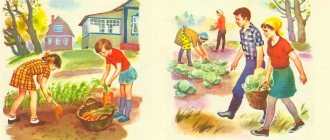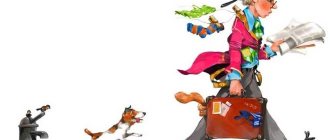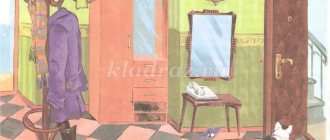Summary of a frontal lesson in a senior speech therapy group
Summary of the frontal lesson “Kolobok’s Journey” in the senior speech therapy group.
Summary of a speech therapy lesson aimed at developing the phonetic-phonemic aspect of speech in children using health-saving technologies
Author: Marina Alekseevna Durneva, teacher-speech therapist, MBDOU kindergarten No. 17, Kamensk-Shakhtinsky. Description: This lesson was conducted in a senior speech therapy group. When preparing the lesson, the emphasis was on the lexical topic “Autumn”. This lesson will be useful for speech therapists and preschool teachers. Goals and objectives: Correctional and educational:
• teach children to characterize the sounds [y] and [a], select words for a given sound.
• introduce children to the sound [p] and the way it is characterized based on articulatory and acoustic features; • introduce the concept of a “voiceless consonant” and the location of the sound at the beginning of a word; • learn to identify sounds in syllables and words. Correctional and developmental:
• develop general, fine and articulatory motor skills of children;
• develop phonemic processes; • develop breathing and voice; • consolidate the concepts: “sound”; • improve children's communication skills; • increase speech activity; • develop melodic-intonation and prosodic aspects of speech; • develop mental processes; • increase performance and endurance. Correctional-educational:
• to develop in children the ability to finish what they start, perseverance and the ability to handle handouts.
Equipment: pictures of fairy tale characters, leaves with pictures, a river, a bridge, counting sticks, pictures for articulation gymnastics, an illustration of the “Letter P,” a tape recorder, a board.
Progress of the lesson:
1. Organizational moment. Speech therapist: To be polite, you need to say hello to everyone you meet - children know this. You say hello, and in response, Children will say: Hello, hello! Speech therapist: Let's say hello to our guests (children say hello). Now let's say hello to each other. Logori (development of communication skills, initiative behavior, speed of reaction).
2. Main part. Teacher: Guess the riddle: I didn’t tremble before the wolf, I ran away from the bear, But I got caught in the fox’s teeth... (Kolobok) Let’s come up with our own fairy tale about Kolobok. Who will help us with this? (smart head) Then let's do some brain exercises. It will help you become attentive, active, relieve tension, fear, irritation and improve your achievements! Kinesiological exercises.
• “Ear – nose – cotton” - with your left hand, grab the tip of your nose, and with your right hand, grab the opposite ear. At the same time, release your ear and nose, clap your hands, change the position of your hands “exactly the opposite.” •“Fist – rib – palm.”
Who else will help us?
(tongue). Articulation gymnastics. Children perform exercises according to the text they heard and the picture they saw:
“We open our mouth - house, who is the boss in that house? The owner in it, the tongue, rested on his lip with a spatula (“Spatula”). The tongue goes out for a walk, it goes around the house (lick lips in a circle). Who is here and who is there? He looks around (“Watch”). He sees: the lips are very flexible, deftly stretching towards a smile (“Fence”), And now, on the contrary, the lips are stretching forward (“Elephant”). The tongue has become a painter, carefully painting the house (“Painter”). He found himself on a swing, flying up and going down (“Swing”). Who could guess? Our tongue is like a fungus! (“Fungus”) The tongue became an accordion, played and did not get tired (“Accordion”). Tired of transformations: Tongue licks jam (“Tasty Jam”). He loves to eat sweets, and then he gallops like a horse (“Horse”).
Well, now are you ready to come up with an interesting fairy tale?
Then let's begin. Grandma baked Kolobok. And now we’ll show you how she baked it. Finger gymnastics “Let’s bake a bun” - development of fine motor skills.
“Collecting flour from bottom to bottom” - children spread their fingers wide, then clench them into a fist.
“Knead the dough” - children move the fingers of one hand over the palm of the other clockwise, then change the position of their hands. “Roll out the dough” - rub your palm against your palm. “Make a Kolobok” - put palm on palm - “roll the ball.” Grandma baked Kolobok. I put it in the window to cool. The bun lay and lay. He jumped off the window and rolled (children perform the movement to the music). Logori (development of communication skills, initiative behavior, speed of reaction).
And there is a river on the way.
How do we get to the other side? Children offer answer options (swim across by boat, on a speedboat, on a ship). Speech therapist: You can walk across the bridge. But the bridge is not simple, this bridge is sound. The one who names words with the sound A or U will pass. Children name the words and walk across the bridge.
He crossed the river, sat down on a tree stump and sang (the children sing to the music): 1. I left my grandmother, I left my grandfather. This is the kind of bun I am, Kolobok is a ruddy side. 2. Oh, how good I am! How I love myself! I hug you tightly and inhale through my nose. Breathing exercise “Hug your shoulders” (according to A. N. Strelnikova).
Children stand straight and straight, their legs are slightly narrower. Than shoulder width apart; arms are bent at the elbows, raised to chest level and spread to the sides. In this case, one hand should be placed slightly lower. On the count of “one”, we hug ourselves so that the elbows are close to each other in one place, the arms form a triangle - inhale! After making 4 inhalation movements, you need to rest for a few seconds and perform this exercise again 4 times. And so 4 times, 4 inhalation movements.
A bunny runs past.
The Hare saw Kolobok and said: “Kolobok, Kolobok - I’ll eat you.” And Kolobok says: “Don’t eat me, let’s play instead.” The Hare thought and agreed. Game "Collect leaves".
Leaves are scattered around the room, children are spinning like leaves to the calm music. The music stops playing, everyone must take 1 leaf. There is a picture on the reverse side. Look at the picture and say the word. What is the first sound in this word? In all the words we encountered the sound “P”. Let's say it again and watch how we do it. Does the air come out easily or does it meet a barrier? What kind of barrier is this? (lips). So will the sound “P” be a vowel or a consonant? (consonant) Now put your hand on the neck and pronounce the sound “P”. Is the neck silent or trembling? (silent) So this sound is dull. And in writing this sound will be indicated by the letter “P” - showing the letter. Bunny says that he has instructions on how to make the letter “P” from sticks, but he won’t understand anything. Let's help him. The letter P is a doorway. We'll take three sticks. Let's fold the two into a straight path. We'll put the third one on top. Have you figured out how to make the letter “P” from sticks? Then go behind the tables and fold this letter for the bunny.
The hare thanks the children and leaves.
As soon as the hare ran away, the Wolf ran to meet Kolobok and said: “Kolobok, Kolobok - I’ll eat you.” And Kolobok says: “Don’t eat me, let me tell you what I learned about the sound “P.” The wolf thought and agreed. Children repeat the characteristics of the sound “P” - the sound “P” is consonant and unvoiced, denoted by the letter “P”. The Wolf was surprised by Kolobok’s knowledge and said: “Okay, I won’t eat you. But you have to play with me.” Game for the development of phonemic hearing “Clap-stomp”
The wolf thanks the children and leaves.
Only the Wolf ran away, the Bear goes to meet Kolobok and says: “Kolobok, Kolobok - I will eat you.” And Kolobok says: “Don’t eat me, let me tell you what I learned about the sound “P.” Children repeat the characteristics of the sound “P” - the sound “P” is consonant and unvoiced, denoted by the letter “P”. The Bear was surprised and said: You know about the sound “P”, but not everything. This sound can also be indicated by the color blue because it is a consonant. I won't eat you if you complete my task. Game "How many sounds?"
The speech therapist pronounces the syllables AP, UP. Children name sounds in syllables, characterize them and lay out diagrams.
The bear thanks the children and leaves.
As soon as the Bear has left, the Little Fox comes along. She saw Kolobok and said: “Kolobok, Kolobok - I’ll eat you.” And Kolobok says: “Don’t eat me, I’ll tell you a poem”: Pa-pa-pa - there is cereal on the table. Py-p-p-p - no cereal. Oop-op-op - everyone clap their hands. Whoop-whoop-whoop – Vanya’s soup is delicious. Yip-ip-ip - Philip came to us. Whoop-whoop-whoop – we ate the soup. The fox listened to the poem and said: Okay, I won’t eat you, but first let’s play a game. Pa-pa-pa, here comes the fox! Pa-pa-pa, so I’ll eat Kolobok! Py-poy-poy, and I’ll hide from the Fox! Pa-pa-pa, you won’t catch Kolobok! Children, standing in a circle, chant the words. In the center of the circle is the Fox, behind the circle is Kolobok. Having sung all the words, the children raise their clasped hands high up, making “collars.” And the Fox catches up with Kolobok, running after him around the circle. When the music ends, the game stops. Fox Kolobok didn’t catch him, got offended and ran away. Relaxation exercise “Kolobok is resting.”
Children sing the words of Kolobok: Children (sing): I was tired, I was in a hurry, I almost got lost. I’ll lie down in the clearing and look at the sky. If they lose, children lie down on the carpet and rest.
The teacher continues to sing himself: Hush, hush, don’t make noise, Don’t wake up the Kolobochki! The birds will begin to chirp, We will open our eyes, The children open their eyes and stand up. And now it’s time to say goodbye, Let’s say to everyone: “Goodbye! Bye!"
We recommend watching:
Summary of an individual educational activity with a 5-6-year-old pupil for the correction of sound pronunciation. Notes of an educational activity in a senior speech therapy group. Notes of a lesson in a senior speech therapy group. Notes of an individual correctional and developmental speech therapy lesson. Senior group
Similar articles:
Summary of educational activities in the older group of children with severe speech impairments on the topic: “Sounds S - Z”
Summary of educational activities in the senior group of children with severe speech impairments on the topic: “Sounds S - Sh”
Summary of a subgroup GCD to eliminate disturbances in sound pronunciation in children of the older group with severe speech impairments
Summary of educational activities in the senior speech therapy group on the topic “Cossacks and their traditions”
Logorhythmic lesson for children of senior preschool age with special needs on the topic: “What types of transport are there?”
Topics for open classes
Choosing a topic is not an easy task, since the specialist will have to demonstrate something new. You can use thematic calendar planning.
Lexical topic “Transport”
Equipment you will need is a set of thematic pictures, a bag of small toys, and model airplanes and trucks. On the lexical topic “Transport” in the senior group, the speech therapist aims to expand ideas and form vocabulary.
At the organizational moment, riddles are asked to each child. Afterwards, the teacher asks leading questions and asks the children what will be discussed. All children are given a picture of a vehicle, and they tell them what they will use to go to kindergarten.
Important! Group work involves the participation of the entire team.
Next, a task is given with the need to complete the sentence. Discuss different types of transport with children - water, land, air. In the middle of the lesson there is a physical education session.
On mock-ups, parts of the machine are disassembled - the nose of the aircraft, wings, tail, etc. The end of the lesson is accompanied by a brief summary. As homework, they are asked to come up with a drawing of “travel to another country” and each child chooses his own mode of transport.
Organization of a nature corner in kindergartens according to the Federal State Educational Standard
Theme "Mom's Day"
In kindergarten, preschoolers must receive a certain set of knowledge, skills, abilities - this is enshrined in the Federal State Educational Standard. Therefore, the teacher and speech therapist conduct classes dedicated to various holidays.
Exciting games allow you to form ideas about certain traditions
The family plays a big role in raising a child. Therefore, the teacher begins the lesson with a short introduction. He brings a small package into the office and offers to find out what is hidden in it. Inside is a message written on a postcard.
The teacher talks about March 8th as a mother’s holiday. Then various tasks are offered: “clean up the picture,” “buy groceries at the store,” “housework,” “cook dinner for mom,” etc.
Theme "Spring" for the middle group
When holding any event, the age characteristics of children must be taken into account. Speech therapy classes in the middle group are carried out according to the same plan as in the senior group. But simple material is selected for it.
At the beginning, a short physical education session is held, then spring phenomena are discussed with the children - melting snow and ice, warming, etc. Next, preschoolers are asked to remember which birds return at this time of year.
Important! You can invite them to describe an animal that also wakes up in the spring - a bear. Another option for the task is “name it affectionately.”
The theme “Spring” speech therapy lesson in the middle group should achieve certain goals. In this case, it is necessary to develop a thematic vocabulary.
Topic "Furniture" in the senior group
Throughout the year, children are introduced to different materials. At the beginning of the lesson, they are given a small task (“call your friend affectionately” or something else). Then thematic sets of pictures are distributed. The lexical topic “Furniture” in the senior speech therapy group is aimed at developing vocabulary.
To begin with, children are given thematic riddles, then they are asked to listen to the words and eliminate the unnecessary, in addition they are taught to select signs for the subject.
You can start the lesson with the task “find what is wrong in the picture” or others. In the middle there must be a physical training session. The lexical topic “Furniture” in a preparatory speech therapy group may include tasks with letters. For example, “find the mistake in the word.”
Theme "Family"
For the development of coherent speech, it is important that the child can communicate on everyday topics. Everyday events are used for this. During the lesson, children discuss who the family members are, what they do and what professions they have.
Drawing classes in senior groups of preschool educational institutions
Theme: “Travel through the taiga”
In the garden, children should receive their first ideas about the world. Therefore, they are told about the features of nature - what wild animals live where, what they eat and what they do.
Lotto and other games help make the activity interesting
An effective means of developing speech is to compose a short story using reference pictures. This will teach children to formulate thoughts correctly. They must clearly understand the difference between wild and domestic animals.
Theme "Hats"
The organizational moment begins with riddles. Next, the toy Dunno is shown and the teacher draws attention to his headdress - a blue hat.
Examples of tasks are “Count”, “what is a thing made of”, “what hats were given to whom”, etc. You can add questions about what hats are worn in the fall and other seasons.
For all tasks, visual material must be used. Additionally, you can ask what sound the word begins with. During work, children must change types of activities and therefore physical education sessions are carried out with them.
You can give tasks to eliminate unnecessary things: “Do they wear a cap in winter?”, “Do they wear a hat in summer?” and so on.
Important! All children must participate during the lesson.
Be sure to disassemble parts of the headdress - brim, visor and others. You can find out what clothes the children remember. The speech therapist needs to select interesting games that will attract attention. In the older group, you can add riddles to develop literacy - add a letter, etc.



